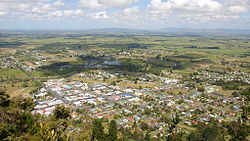Matamata-Piako District
Matamata-Piako District | |
|---|---|
 Te Aroha | |
 Matamata-Piako district within the North Island | |
| Coordinates: 37°42′18″S 175°39′43″E / 37.705°S 175.662°E | |
| Country | New Zealand |
| Region | Waikato |
| Wards | Matamata Morrinsville Te Aroha Te Toa Horopū ā Matamata-Piako (Māori) |
| Seat | Te Aroha |
| Government | |
| • Mayor | Adrienne Wilcock |
| • Territorial authority | Matamata-Piako District Council |
| Area | |
| • Land | 1,755.35 km2 (677.74 sq mi) |
| Population (June 2024)[2] | |
| • Total | 39,300 |
| Time zone | UTC+12 (NZST) |
| • Summer (DST) | UTC+13 (NZDT) |
| Postcode(s) | |
| Website | Matamata-Piako District Council |
Matamata-Piako District is a local government area in the Waikato region of New Zealand. It lies to the east of the city of Hamilton.
Geography
[edit]The district encompasses the southern end of the Hauraki Plains and much of the Thames Valley, and is bounded in the east by the Kaimai Range. The rivers Piako and Waihou run through the district.
The towns of Matamata, Morrinsville and Te Aroha are all within the district, with the Council's head office based in Te Aroha. The main industry in the region is dairy farming and Thoroughbred breeding and training. Other communities in the district include Mangateparu and Waitoa.
Populated places
[edit]Matamata-Piako District consists of the following towns, localities, settlements and communities:
|
|
Demographics
[edit]Matamata-Piako District covers 1,755.35 km2 (677.74 sq mi)[1] and had an estimated population of 39,300 as of June 2024,[2] with a population density of 22.4 people per km2. 9,710 people live in Morrinsville, 9,610 in Matamata, and 4,700 in Te Aroha.
| Year | Pop. | ±% p.a. |
|---|---|---|
| 2006 | 30,483 | — |
| 2013 | 31,536 | +0.49% |
| 2018 | 34,404 | +1.76% |
| 2023 | 37,098 | +1.52% |
| Source: [3][4] | ||
Matamata-Piako District had a population of 37,098 in the 2023 New Zealand census, an increase of 2,694 people (7.8%) since the 2018 census, and an increase of 5,562 people (17.6%) since the 2013 census. There were 18,360 males, 18,654 females and 81 people of other genders in 14,049 dwellings.[5] 2.1% of people identified as LGBTIQ+. The median age was 40.8 years (compared with 38.1 years nationally). There were 7,302 people (19.7%) aged under 15 years, 6,189 (16.7%) aged 15 to 29, 15,618 (42.1%) aged 30 to 64, and 7,986 (21.5%) aged 65 or older.[4]
People could identify as more than one ethnicity. The results were 83.3% European (Pākehā); 18.6% Māori; 2.6% Pasifika; 6.9% Asian; 0.9% Middle Eastern, Latin American and African New Zealanders (MELAA); and 2.0% other, which includes people giving their ethnicity as "New Zealander". English was spoken by 96.7%, Māori language by 4.1%, Samoan by 0.2% and other languages by 7.5%. No language could be spoken by 2.2% (e.g. too young to talk). New Zealand Sign Language was known by 0.5%. The percentage of people born overseas was 15.7, compared with 28.8% nationally.
Religious affiliations were 30.9% Christian, 0.9% Hindu, 0.4% Islam, 1.0% Māori religious beliefs, 0.9% Buddhist, 0.4% New Age, and 1.7% other religions. People who answered that they had no religion were 55.4%, and 8.4% of people did not answer the census question.
Of those at least 15 years old, 3,309 (11.1%) people had a bachelor's or higher degree, 16,698 (56.0%) had a post-high school certificate or diploma, and 8,826 (29.6%) people exclusively held high school qualifications. The median income was $40,000, compared with $41,500 nationally. 2,655 people (8.9%) earned over $100,000 compared to 12.1% nationally. The employment status of those at least 15 was that 14,922 (50.1%) people were employed full-time, 4,143 (13.9%) were part-time, and 621 (2.1%) were unemployed.[4]

| Name | Area (km2) |
Population | Density (per km2) |
Dwellings | Median age | Median income |
|---|---|---|---|---|---|---|
| Morrinsville General Ward | 573.00 | 13,782 | 24.1 | 5,058 | 37.7 years | $44,200[6] |
| Te Aroha General Ward | 517.10 | 8,430 | 16.3 | 3,285 | 43.4 years | $35,900[7] |
| Matamata General Ward | 665.25 | 14,883 | 22.4 | 5,706 | 42.7 years | $39,100[8] |
| New Zealand | 38.1 years | $41,500 |
Twin cities
[edit]Matamata-Piako is twinned with:
References
[edit]- ^ a b "ArcGIS Web Application". statsnz.maps.arcgis.com. Retrieved 1 March 2022.
- ^ a b "Aotearoa Data Explorer". Statistics New Zealand. Retrieved 26 October 2024.
- ^ "Statistical area 1 dataset for 2018 Census". Statistics New Zealand. March 2020. Matamata-Piako District (015). 2018 Census place summary: Matamata-Piako District
- ^ a b c "Totals by topic for individuals, (RC, TALB, UR, SA3, SA2, Ward, Health), 2013, 2018, and 2023 Censuses". Stats NZ - Tatauranga Aotearoa - Aotearoa Data Explorer. Matamata-Piako District (015). Retrieved 3 October 2024.
- ^ "Totals by topic for dwellings, (RC, TALB, UR, SA3, SA2, Ward, Health), 2013, 2018, and 2023 Censuses". Stats NZ - Tatauranga Aotearoa - Aotearoa Data Explorer. Retrieved 3 October 2024.
- ^ "Totals by topic for individuals, (RC, TALB, UR, SA3, SA2, Ward, Health), 2013, 2018, and 2023 Censuses". Stats NZ - Tatauranga Aotearoa - Aotearoa Data Explorer. Morrinsville General Ward. Retrieved 3 October 2024.
- ^ "Totals by topic for individuals, (RC, TALB, UR, SA3, SA2, Ward, Health), 2013, 2018, and 2023 Censuses". Stats NZ - Tatauranga Aotearoa - Aotearoa Data Explorer. Te Aroha General Ward. Retrieved 3 October 2024.
- ^ "Totals by topic for individuals, (RC, TALB, UR, SA3, SA2, Ward, Health), 2013, 2018, and 2023 Censuses". Stats NZ - Tatauranga Aotearoa - Aotearoa Data Explorer. Matamata General Ward. Retrieved 3 October 2024.
- ^ "Sister City Agreement". Archived from the original on 31 August 2007. Retrieved 10 July 2009.
